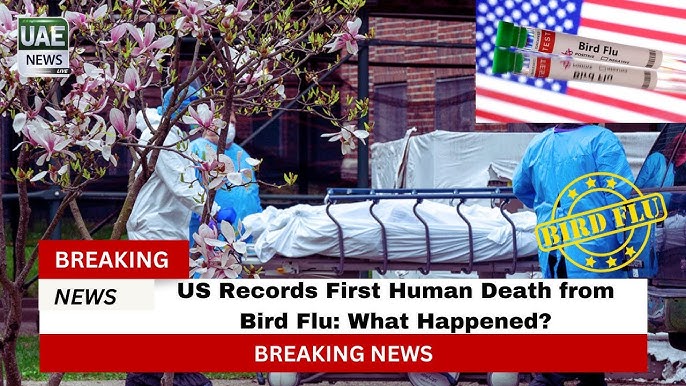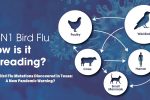First Human Death from Bird Flu in the USA Sparks Widespread Concerns
The United States has reported its first human death from bird flu, marking a significant and alarming milestone in the ongoing outbreak. This tragic incident comes nearly nine months after the first human case of bird flu was detected in the country. Since then, the virus has spread extensively, affecting hundreds of herds and millions of birds before eventually infecting humans.
As of January 6, the Centers for Disease Control and Prevention (CDC) has reported 66 confirmed human cases of bird flu in 10 different states. Most infections have been associated with direct contact with infected livestock or birds, underlining the occupational risks faced by farmers and poultry workers. Despite these developments, the CDC continues to reassure the public that the risk of human-to-human transmission remains low at this time.
First Fatal Case: What Happened?
The first reported death occurred in Louisiana, involving a patient over the age of 65 who had underlying health conditions. This vulnerable individual succumbed to the infection, raising fresh concerns about the potential risks to high-risk populations.
Health officials have emphasized that, as of now, there is no evidence of the virus spreading directly between humans. While this isolated case is concerning, experts stress that maintaining vigilance and taking proactive measures will be critical in managing future risks.
Dr. Tony Moody, a pediatric infectious diseases expert at Duke University, described the situation as both alarming and reassuring. “Although human-to-human transmission hasn’t occurred yet, there is still a possibility that mutations may enable the virus to spread more easily between people, which remains a significant concern,” he explained.
Concerns Over Mutations and Reassortment
One of the most pressing concerns among scientists is the potential for the bird flu virus to mutate, enhancing its ability to spread between humans. The Louisiana case, in particular, has highlighted this risk. Genetic analysis of the virus revealed mutations not found in poultry samples from the patient’s property, suggesting that the virus may be evolving after infecting humans.
In addition to mutations, there is also a looming fear of reassortment. This occurs when two different flu viruses infect the same host, potentially combining genetic material to form a new, hybrid strain.
Dr. Peter Hotez, co-director of the Texas Children’s Hospital Center for Vaccine Development, explained the stakes: “While mutations are concerning, the greater likelihood lies in reassortment, which could spark an epidemic or even a pandemic.” This highlights the critical need for continued monitoring of genetic changes in the virus.
Differences in Genotypes: A Key to Severity
The genetic makeup of the virus is another factor that influences the severity of cases. According to Dr. Meghan Davis from Johns Hopkins Bloomberg School of Public Health, the strain affecting dairy cows and poultry in the U.S. has generally resulted in milder cases in humans.
However, the Louisiana case involved a genotype commonly found in wild birds, which is known to cause more severe illness. The varying genetic profiles of this virus show just how unpredictable avian flu can be.
Improving Testing for Better Preparedness
To better monitor and manage the spread of bird flu, U.S. health agencies are ramping up their testing efforts. The Department of Agriculture has introduced new regulations requiring the examination of raw milk samples, and the FDA has begun testing aged raw milk cheeses for potential contamination. This expanded surveillance aims to catch cases early and prevent widespread transmission.
Dr. Hotez emphasized the importance of making bird flu testing more widely available. Accessible testing is not just about identifying cases more quickly—it’s also crucial for detecting any mutations or reassortments that could enhance the virus’s ability to spread.
Stockpiling Vaccines for Future Outbreaks
The U.S. government is taking proactive steps to prepare for a potentially more severe outbreak. In July, Moderna received $176 million to develop an mRNA-based bird flu vaccine, building on the success of mRNA technology during the COVID-19 pandemic. Additionally, $72 million has been allocated to ensure that existing vaccines are ready for immediate use if needed.
While these efforts are commendable, experts caution that current vaccines in the government’s stockpile target older strains of bird flu. This raises questions about their effectiveness against newer variants. Dr. Moody acknowledged the challenge of predicting which strain will pose the greatest threat but remains optimistic about the country’s ability to respond effectively.
“We’re better positioned today than we were in 2020 with COVID,” Dr. Moody said. “We know how to create and distribute vaccines, which puts us in a stronger place to respond to potential outbreaks.”
Challenges Ahead: Preparedness and Vigilance
As the world enters 2025, the bird flu situation serves as a stark reminder of the unpredictability of zoonotic diseases. The first human death in the U.S. underscores the need for increased vigilance and proactive measures.
While the virus has not yet shown signs of sustained human-to-human transmission, experts warn that this could change at any time. The combined risks of mutation and reassortment make it imperative to invest in robust monitoring systems, vaccine development, and public awareness campaigns.
Early investments in research, testing, and vaccination infrastructure could make all the difference in preventing a larger crisis. As Dr. Hotez aptly put it, “Preparedness is our best defense against the unknown.”
Conclusion: Staying Ahead of the Threat
The ongoing bird flu outbreak has reached a critical juncture, with the first human death serving as a wake-up call for public health authorities. By prioritizing research, enhancing testing capabilities, and advancing vaccine development, the U.S. can mitigate the risks of a larger outbreak.
Experts agree that vigilance, combined with proactive measures, will be essential in managing the bird flu threat in the years to come. While the current risk to the general population remains low, staying prepared is the key to safeguarding public health.
Disclaimer
Our editorial team has thoroughly fact-checked this article to ensure its accuracy and eliminate any potential misinformation. We are dedicated to upholding the highest standards of integrity in our content.





More Stories
Bird Flu Human Death USA: First Reported Fatal Case Sparks Concerns in 2025
Bird Flu Human Death USA: First Reported Fatal Case Sparks Concerns in 2025
Bird Flu Human Death USA: First Reported Fatal Case Sparks Concerns in 2025